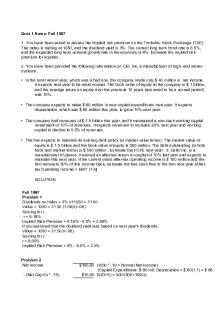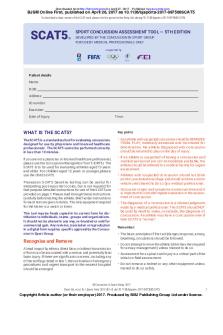MCN Quizlet Reviewer Merged PDF

| Title | MCN Quizlet Reviewer Merged |
|---|---|
| Course | Dental Medicine |
| Institution | Southwestern University PHINMA |
| Pages | 238 |
| File Size | 4 MB |
| File Type | |
| Total Downloads | 6 |
| Total Views | 157 |
Summary
Maternal and childcare reviewer from quizlet...
Description
11/15/21, 12:31 AM
Intrapartu
Intrapartum NCLEX questions Flashcards | Quizlet
NCLEX questions
Study
Intrapartum NCLEX questions Terms in this set (41) 1.A nurse is caring for a client in
1.4. The second stage of labor begins when the
labor. The nurse determines
cervix is dilated completely and ends with the birth
that the client is beginning in
of the neonate.
the 2nd stage of labor when which of the following assessments is noted? A.The client begins to expel clear vaginal fluid B.The contractions are regular C.The membranes have ruptured D.The cervix is dilated completely
h
4
11/15/21, 12:31 AM
Intrapartum NCLEX questions Flashcards | Quizlet
Intrapartum NCLEX questions
Study
phases of labor. The nurse is
and oxygen to the fetus during the uterine
assessing the fetal patterns and
contractions. This causes hypoxemia; therefore
notes a late deceleration on
oxygen is necessary. The supine position is avoided
the monitor strip. The most
because it decreases uterine blood flow to the
appropriate nursing action is
fetus. The client should be turned to her side to
to:
displace pressure of the gravid uterus on the inferior vena cava. An intravenous pitocin infusion is
1.Place the mother in the
discontinued when a late deceleration is noted.
supine position 2.Document the findings and continue to monitor the fetal patterns 3.Administer oxygen via face mask 4.Increase the rate of pitocin IV infusion
A nurse is performing an
1. A normal fetal heart rate is 120-160 beats per
assessment of a client who is
minute. A count of 180 beats per minute could
scheduled for a cesarean
indicate fetal distress and would warrant physician
delivery. Which assessment
notification. By full term, a normal maternal
finding would indicate a need
hemoglobin range is 11-13 g/dL as a result of the
to contact the physician?
hemodilution caused by an increase in plasma volume during pregnancy.
1.Fetal heart rate of 180 beats per minute 2.White blood cell count of 12,000 3.Maternal pulse rate of 85 beats per minute 4.Hemoglobin of 11.0 g/dL
h
4
11/15/21, 12:31 AM
Intrapartum NCLEX questions Flashcards | Quizlet
Intrapartum NCLEX questions
Study
prepared for a cesarean
lower trunk and extremities. This leads to decreasing
delivery. The client is
cardiac return, cardiac output, and blood flow to
transferred to the delivery
the uterus and the fetus. The best position to
room table, and the nurse
prevent this would be side-lying with the uterus
places the client in the:
displaced off of abdominal vessels. Positioning for abdominal surgery necessitates a supine position;
1.Trendelenburg's position with
however, a wedge placed under the right hip
the legs in stirrups
provides displacement of the uterus.
2.Semi-Fowler position with a pillow under the knees 3.Prone position with the legs separated and elevated 4.Supine position with a wedge under the right hip
h
4
11/15/21, 12:31 AM
Intrapartum NCLEX questions Flashcards | Quizlet
Intrapartum NCLEX questions
Study
auscultate the fetal heart rate
fetal heart rate to differentiate the two. If the fetal
by using a Doppler ultrasound
and maternal heart rates are similar, the nurse may
device. The nurse most
mistake the maternal heart rate for the fetal heart
accurately determines that the
rate. Leopold's maneuvers may help the examiner
fetal heart sounds are heard
locate the position of the fetus but will not ensure a
by:
distinction between the two rates.
1.Noting if the heart rate is greater than 140 BPM 2.Placing the diaphragm of the Doppler on the mother abdomen 3.Performing Leopold's maneuvers first to determine the location of the fetal heart 4.Palpating the maternal radial pulse while listening to the fetal heart rate
h
4
11/15/21, 12:31 AM
Intrapartum NCLEX questions Flashcards | Quizlet
Intrapartum NCLEX questions
Study
by IV infusion to stimulate
indicate fetal distress and the need to discontinue to
uterine contractions. Which
pitocin. The goal of labor augmentation is to
assessment finding would
achieve three good-quality contractions in a 10-
indicate to the nurse that the
minute period.
infusion needs to be discontinued? 1.Three contractions occurring within a 10-minute period 2.A fetal heart rate of 90 beats per minute 3.Adequate resting tone of the uterus palpated between contractions 4.Increased urinary output
A nurse is beginning to care for
2. Continuous electronic fetal monitoring should be
a client in labor. The physician
implemented during an IV infusion of Pitocin.
has prescribed an IV infusion of Pitocin. The nurse ensures that which of the following is implemented before initiating the infusion? 1.Placing the client on complete bed rest 2.Continuous electronic fetal monitoring 3.An IV infusion of antibiotics 4.Placing a code cart at the client's bedside
h
4
11/15/21, 12:31 AM
Intrapartum NCLEX questions Flashcards | Quizlet
Intrapartum NCLEX questions
Study
client is having contractions
indicate the need for immediate medical
every 3 minutes that last 45
management, and the physician or nurse mid-wife
seconds. The nurse notes that
needs to be notified.
the fetal heart rate between contractions is 100 BPM. Which of the following nursing actions is most appropriate? 1.Encourage the client's coach to continue to encourage breathing exercises 2.Encourage the client to continue pushing with each contraction 3.Continue monitoring the fetal heart rate 4.Notify the physician or nurse mid-wife
h
4
11/15/21, 12:31 AM
Intrapartum NCLEX questions Flashcards | Quizlet
Intrapartum NCLEX questions
Study
fetal heart rate patterns. The
caused by fetal movement. Episodic accelerations
nurse notes the presence of
are thought to be a sign of fetal-well being and
episodic accelerations on the
adequate oxygen reserve.
electronic fetal monitor tracing. Which of the following actions is most appropriate? 1.Document the findings and tell the mother that the monitor indicates fetal well-being 2.Take the mothers vital signs and tell the mother that bed rest is required to conserve oxygen. 3.Notify the physician or nurse mid-wife of the findings. 4.Reposition the mother and check the monitor for changes in the fetal tracing
h
4
11/15/21, 12:31 AM
Intrapartum NCLEX questions Flashcards | Quizlet
Intrapartum NCLEX questions attaches an external electronic
Study
baseline rate will be identified if they occur.
fetal monitor to the client's abdomen. After attachment of
Options 1 and 3 are important to assess, but not as
the monitor, the initial nursing
the first priority.
assessment is which of the following? 1.Identifying the types of accelerations 2.Assessing the baseline fetal heart rate 3.Determining the frequency of the contractions 4.Determining the intensity of the contractions
A nurse is reviewing the record
1. Station is the relationship of the presenting part to
of a client in the labor room
an imaginary line drawn between the ischial spines,
and notes that the nurse
is measured in centimeters, and is noted as a
midwife has documented that
negative number above the line and a positive
the fetus is at -1 station. The
number below the line. At -1 station, the fetal
nurse determines that the fetal
presenting part is 1 cm above the ischial spines.
presenting part is: 1.1 cm above the ischial spine 2.1 fingerbreadth below the symphysis pubis 3.1 inch below the coccyx 4.1 inch below the iliac crest
h
4
11/15/21, 12:31 AM
Intrapartum NCLEX questions Flashcards | Quizlet
Intrapartum NCLEX questions
Study
is performed, and the nurse
infection, and poor wound healing. Anemia does
notes that the client's
not specifically present a risk for hemorrhage.
hemoglobin and hematocrit
Having a loud mouth is only related to the person
levels are low, indicating
typing up this test.
anemia. The nurse determines that the client is at risk for which of the following? 1.A loud mouth 2.Low self-esteem 3.Hemorrhage 4.Postpartum infections
A nurse assists in the vaginal
4. As the placenta separates, it settles downward
delivery of a newborn infant.
into the lower uterine segment. The umbilical cord
After the delivery, the nurse
lengthens, and a sudden trickle or spurt of blood
observes the umbilical cord
appears.
lengthen and a spurt of blood from the vagina. The nurse documents these observations as signs of: 1.Hematoma 2.Placenta previa 3.Uterine atony 4.Placental separation
h
4
11/15/21, 12:31 AM
Intrapartum NCLEX questions Flashcards | Quizlet
Intrapartum NCLEX questions
Study
membranes are still intact, and
augment labor if the process begins to slow.
the nurse-midwife prepares to
Rupturing of membranes allows the fetal head to
perform an amniotomy. A nurse
contact the cervix more directly and may increase
who is assisting the nurse-
the efficiency of contractions.
midwife explains to the client that after this procedure, she will most likely have: 1.Less pressure on her cervix 2.Increased efficiency of contractions 3.Decreased number of contractions 4.The need for increased maternal blood pressure monitoring
A nurse is monitoring a client in
2. Variable decelerations occur if the umbilical cord
labor. The nurse suspects
becomes compressed, thus reducing blood flow
umbilical cord compression if
between the placenta and the fetus. Early
which of the following is noted
decelerations result from pressure on the fetal head
on the external monitor tracing
during a contraction. Late decelerations are an
during a contraction?
ominous pattern in labor because it suggests uteroplacental insufficiency during a contraction.
1.Early decelerations
Short-term variability refers to the beat-to-beat
2.Variable decelerations
range in the fetal heart rate.
3.Late decelerations 4.Short-term variability
h
4
11/15/21, 12:31 AM
Intrapartum NCLEX questions Flashcards | Quizlet
Intrapartum NCLEX questions
Study
labor. The nurse tells the client
and is used before transition to promote relaxation
that effleurage is:
and relieve mild to moderate pain. Effleurage provides tactile stimulation to the fetus.
1.A form of biofeedback to enhance bearing down efforts during delivery 2.Light stroking of the abdomen to facilitate relaxation during labor and provide tactile stimulation to the fetus 3.The application of pressure to the sacrum to relieve a backache 4.Performed to stimulate uterine activity by contracting a specific muscle group while other parts of the body rest
A nurse is caring for a client in
2. Pains, helplessness, panicking, and fear of losing
the second stage of labor. The
control are possible behaviors in the 2nd stage of
client is experiencing uterine
labor.
contractions every 2 minutes and cries out in pain with each contraction. The nurse recognizes this behavior as: 1.Exhaustion 2.Fear of losing control 3.Involuntary grunting 4.Valsalva's maneuver
h
4
11/15/21, 12:31 AM
Intrapartum NCLEX questions Flashcards | Quizlet
Intrapartum NCLEX questions
Study
and notes that the client is
If uterine hypertonicity occurs, the nurse
experiencing hypertonic
immediately would intervene to reduce uterine
uterine contractions. List in
activity and increase fetal oxygenation. The nurse
order of priority the actions
would stop the Pitocin infusion and increase the
that the nurse takes.
rate of the nonadditive solution, check maternal BP for hyper or hypotension, position the woman in a
1.Stop of Pitocin infusion
side-lying position, and administer oxygen by snug
2.Perform a vaginal
face mask at 8-10 L/min. The nurse then would
examination
attempt to determine the cause of the uterine
3.Reposition the client
hypertonicity and perform a vaginal exam to check
4.Check the client's blood
for prolapsed cord
pressure and heart rate 5.Administer oxygen by face mask at 8 to 10 L/min
A nurse is assigned to care for
3. Therapeutic management for hypotonic uterine
a client with hypotonic uterine
dysfunction includes oxytocin augmentation and
dysfunction and signs of a
amniotomy to stimulate a labor that slows.
slowing labor. The nurse is reviewing the physician's orders and would expect to note which of the following prescribed treatments for this condition? 1.Medication that will provide sedation 2.Increased hydration 3.Oxytocin (Pitocin) infusion 4.Administration of a tocolytic medication
h
4
11/15/21, 12:31 AM
Intrapartum NCLEX questions Flashcards | Quizlet
Intrapartum NCLEX questions with hypertonic uterine
Study
promote a normal labor pattern.
dysfunction. The nurse is told that the client is experiencing uncoordinated contractions that are erratic in their frequency, duration, and intensity. The priority nursing intervention would be to: 1.Monitor the Pitocin infusion closely 2.Provide pain relief measures 3.Prepare the client for an amniotomy 4.Promote ambulation every 30 minutes
A nurse is developing a plan of
3. The priority is to monitor the fetal heart rate.
care for a client experiencing dystocia and includes several nursing interventions in the plan of care. The nurse prioritizes the plan of care and selects which of the following nursing interventions as the highest priority? 1.Keeping the significant other informed of the progress of the labor 2.Providing comfort measures 3.Monitoring fetal heart rate 4.Changing the client's position frequently h
4
11/15/21, 12:31 AM
Intrapartum NCLEX questions
Intrapartum NCLEX questions Flashcards | Quizlet
Study
labor who will be delivering twins. The nurse monitors the fetal heart rates by placing the external fetal monitor: 1.Over the fetus that is most anterior to the mothers abdomen 2.Over the fetus that is most posterior to the mothers abdomen 3.So that each fetal heart rate is monitored separately 4.So that one fetus is monitored for a 15-minute period followed by a 15 minute fetal monitoring period for the second fetus
h
4
11/15/21, 12:31 AM
Intrapartum NCLEX questions Flashcards | Quizlet
Intrapartum NCLEX questions
Study
just delivered a newborn infant
intertwining musculature as the fundus of the uterus,
following a pregnancy with
this site is more prone to bleeding.
placenta previa. The nurse reviews the plan of care and prepares to monitor the client for which of the following risks associated with placenta previa? 1.Disseminated intravascular coagulation 2.Chronic hypertension 3.Infection 4.Hemorrhage
A nurse in the delivery room is
4. Signs of placental separation include lengthening
assisting with the delivery of a
of the umbilical cord, a sudden gush of dark blood
newborn infant. After the
from the introitus (vagina), a firmly contracted
delivery of the newborn, the
uterus, and the uterus changing from a discoid (like
nurse assists in delivering the
a disk) to a globular (like a globe) shape. The client
placenta. Which observation
may experience vaginal fullness, but not severe
would indicate that the
uterine cramping. I am going to look more into this
placenta has separated from
answer. According to our book on page 584, this is
the uterine wall and is ready
not one of our options.
for delivery? 1.The umbilical cord shortens in length and changes in color 2.A soft and boggy uterus 3.Maternal complaints of severe uterine cramping 4.Changes in the shape of the uterus
h
4
11/15/21, 12:31 AM
Intrapartum NCLEX questions Flashcards | Quizlet
Intrapartum NCLEX questions
Study
assessment on a pregnant
fetal oxygenation. The mother should be positioned
client in labor. The nurse notes
with the hips higher than the head to shift the fetal
the presence of the umbilical
presenting part toward the diaphragm. The nurse
cord protruding from the
should push the call light to summon help, and
vagina. Which of the following
other staff members should call the physician and
would be the initial nursing
notify the delivery room. No attempt should be
action?
made to replace the cord. The examiner, however, may place a gloved hand into the vagina and hold
1.Place the client in
the presenting part off of the umbilical cord.
Trendelenburg's position
Oxygen at 8 to 10 L/min by face mask is delivered to
2.Call the delivery room to
the mother to increase fetal oxygenation.
notify the staff that the client will be transported immediately 3.Gently push the cord into the vagin...
Similar Free PDFs

MCN Quizlet Reviewer Merged
- 238 Pages

Counterfort Retaining WALL MCN
- 12 Pages

MCN Exam 1 Review
- 13 Pages

Merged (pdf
- 9 Pages

Ilovepdf merged
- 5 Pages

Merged document
- 210 Pages

MCN 2 PDF Transaminasa Proteínas
- 2 Pages

MKT Reviewer Ch. 13 s Quizlet
- 33 Pages

Concussion - merged -
- 23 Pages

MCN Exam 2 Study Guide
- 10 Pages

SQA all merged Mcq
- 35 Pages

1. Financial Analysis-merged
- 10 Pages

Ilovepdf merged - khuj
- 133 Pages

Merged Marine Biology Notes
- 53 Pages

Kritis Asfiksia merged
- 33 Pages
Popular Institutions
- Tinajero National High School - Annex
- Politeknik Caltex Riau
- Yokohama City University
- SGT University
- University of Al-Qadisiyah
- Divine Word College of Vigan
- Techniek College Rotterdam
- Universidade de Santiago
- Universiti Teknologi MARA Cawangan Johor Kampus Pasir Gudang
- Poltekkes Kemenkes Yogyakarta
- Baguio City National High School
- Colegio san marcos
- preparatoria uno
- Centro de Bachillerato Tecnológico Industrial y de Servicios No. 107
- Dalian Maritime University
- Quang Trung Secondary School
- Colegio Tecnológico en Informática
- Corporación Regional de Educación Superior
- Grupo CEDVA
- Dar Al Uloom University
- Centro de Estudios Preuniversitarios de la Universidad Nacional de Ingeniería
- 上智大学
- Aakash International School, Nuna Majara
- San Felipe Neri Catholic School
- Kang Chiao International School - New Taipei City
- Misamis Occidental National High School
- Institución Educativa Escuela Normal Juan Ladrilleros
- Kolehiyo ng Pantukan
- Batanes State College
- Instituto Continental
- Sekolah Menengah Kejuruan Kesehatan Kaltara (Tarakan)
- Colegio de La Inmaculada Concepcion - Cebu
